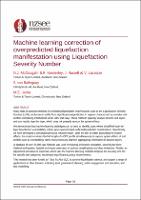Machine Learning Correction of Overpredicted Liquefaction Manifestation using Liquefaction Severity Number

Download
Date
2024-04-09Authors
McDougall, Nathan
van Ballegooy, Sjoerd
Kennerley, Ben
Russell, James
Lacrosse, Virginie
Jacka, Mike
Metadata
Show full item recordAbstract
Many of state-of-practice methods for predicting liquefaction manifestation, such as the Liquefaction Severity Number (LSN) of van Ballegooy et al. (2014) are known to suffer from significant overprediction in regions characterized by complex soil profiles comprising interbedded sands, silts, and clays (Beyzaei et al., 2018). These methods typically analyse discrete soil layers, and sum results layer-by-layer, which does not properly account for system effects.
We demonstrate that machine learning techniques can be used to identify cases where LSN values give overestimated surficial liquefaction manifestation. Specifically, we have developed a convolutional neural network model. With the aim of properly accounting for system effects, the model uses all the data in a CPT profile simultaneously to capture system effects of soil profiles such as interbedding, rather than process and then aggregate information in discrete layers.
A database of 110,000 historical CPT case histories was used for training and model evaluation, spanning ten New Zealand earthquakes. Special techniques have been used to address sampling bias and class imbalance. Finally, an adjustment procedure is proposed, which uses the machine learning model to improve the accuracy of LSN for specific site categories, resulting in significant accuracy improvements.
This research has been funded by Toka Tū Ake to advance liquefaction science, and support a range of applications in New Zealand, including local government planning, public engagement and education, and loss modelling.
